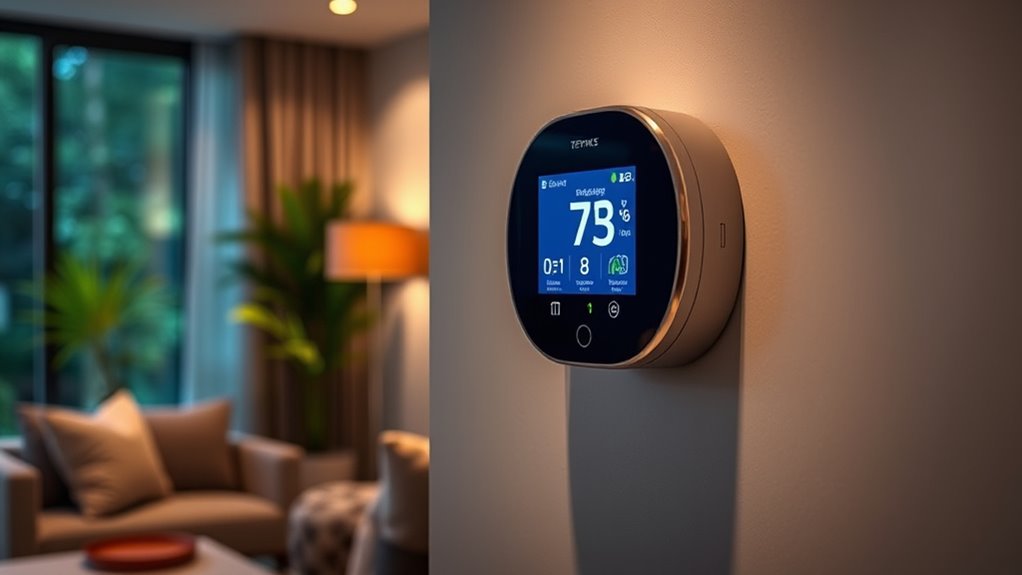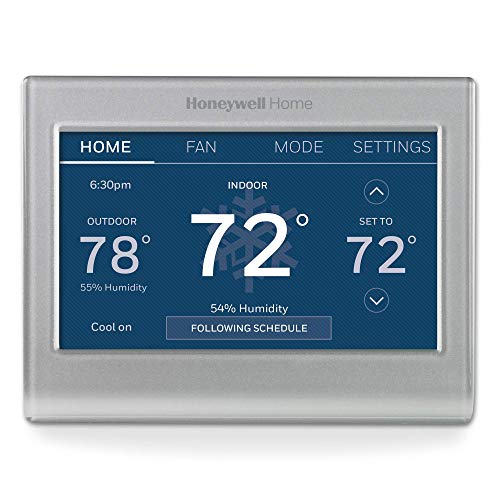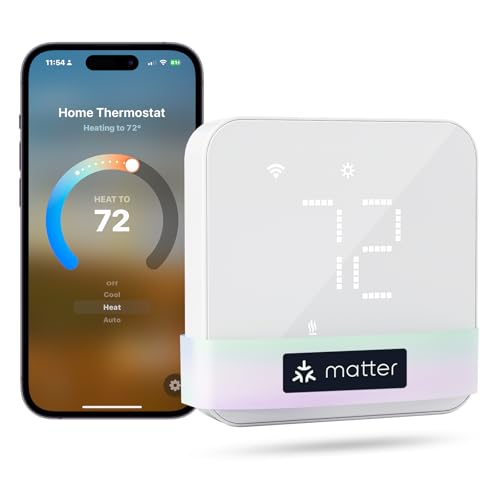If you’re looking to save energy and stay comfortable in 2025, I recommend checking out the top smart thermostats like Ecobee, Nest, and Sensi. These models offer seamless integration with smart home systems, intuitive controls, and advanced features like occupancy sensors and scheduling. Many can cut your energy bills by up to 26%. Stay tuned—there’s more to discover that can help you pick the best one for your needs.
Key Takeaways
- Top models like Ecobee and Nest offer up to 26% energy savings with advanced scheduling, occupancy detection, and adaptive features.
- Compatibility spans most HVAC systems, including central AC, heat pumps, and boilers, with options for wired or wireless installation.
- They integrate seamlessly with popular smart home ecosystems such as Alexa, Google Assistant, Apple HomeKit, and Zigbee.
- Modern designs feature vibrant touchscreens, customizable displays, and user-friendly apps for quick setup and remote control.
- Premium options provide advanced sensors, energy reports, and demand response capabilities to maximize comfort and efficiency.
ecobee Smart Thermostat Essential – Wi-Fi Programmable Thermostat
If you’re looking to cut energy costs without sacrificing comfort, the ecobee Smart Thermostat Essential is an excellent choice. It automatically adjusts to your schedule, saving up to 23% annually on heating and cooling. The thermostat works with most HVAC systems—no C-wire needed with the optional Power Extender Kit—and is easy to install yourself. Its color touchscreen makes temperature adjustments simple, and software updates keep it current. Plus, it integrates seamlessly with Apple, Google, and Alexa, allowing voice control. With energy tracking via the ecobee app and Energy Star certification, this thermostat combines convenience, efficiency, and smart home compatibility.
Best For: homeowners seeking an energy-efficient, easy-to-install smart thermostat that integrates seamlessly with popular smart home ecosystems and offers customizable scheduling.
Pros:
- Saves up to 23% annually on heating and cooling costs with automatic adjustments
- Compatible with 85% of HVAC systems, no C-wire needed with optional PEK
- User-friendly color touchscreen and free software updates for ongoing improvements
Cons:
- May require checking system compatibility before purchase
- Limited advanced features compared to higher-end models
- Some users might find setup challenging without prior DIY experience
Amazon Smart Thermostat
The Amazon Smart Thermostat is an excellent choice for homeowners seeking an affordable yet feature-rich smart thermostat that seamlessly integrates with Alexa. Made with Honeywell technology and ENERGY STAR certified, it helps reduce energy bills while offering convenient control via the Alexa app or compatible Echo devices. It supports scheduling, presence detection, humidity sensing, and automatic adjustments through AI-powered Thermostat Hunches. Installation is straightforward with the Alexa app, though some wiring considerations may apply. While some users report app stability issues and connectivity hiccups, overall, it provides robust automation features at a lower price point, making it a solid option for smart home energy management.
Best For: homeowners seeking an affordable, easy-to-install smart thermostat that integrates seamlessly with Alexa and offers energy-saving features.
Pros:
- Compatible with most 24V HVAC systems and supports multiple automation features.
- User-friendly installation process guided by the Alexa app.
- ENERGY STAR certified, helping reduce energy costs and environmental impact.
Cons:
- Occasional app stability issues and connectivity problems after power outages.
- Requires a C-wire or separate power adapter for installation on certain systems.
- Limited support for 5 GHz Wi-Fi networks, which may affect connectivity in some homes.
Sensi Smart Thermostat
For homeowners seeking an easy-to-install, budget-friendly smart thermostat, the Sensi Smart Thermostat model ST55 stands out as an excellent option. It offers Wi-Fi connectivity, programmable scheduling, and voice control compatibility with Alexa, Google Assistant, SmartThings, and Vera. Its simple 5-inch LED display and intuitive app make setup quick and straightforward, often within 15 minutes. Designed to fit standard wall mounts, it looks like a traditional thermostat but delivers smart features that help save around 23% on energy costs. Battery-powered and easy to configure, the Sensi ST55 is reliable, versatile, and perfect for a variety of residential HVAC systems.
Best For: homeowners seeking an easy-to-install, budget-friendly smart thermostat compatible with various HVAC systems and voice assistants.
Pros:
- Quick and straightforward DIY installation with clear app guidance and included hardware
- Energy-saving features that help reduce HVAC costs by approximately 23%
- Reliable performance with long battery life and a user-friendly interface
Cons:
- Limited compatibility with certain voice assistants like Bixby and some complex HVAC systems
- Basic usage data without detailed intervals, which may limit in-depth system analysis
- Slight delays in system response after temperature adjustments, though generally minimal
ecobee Smart Thermostat Premium with Sensors
The ecobee Smart Thermostat Premium with Sensors stands out as the ideal choice for homeowners seeking both advanced comfort control and energy efficiency. It can save up to 26% annually on heating and cooling costs and is ENERGY STAR certified. The included SmartSensor helps eliminate hot or cold spots by adjusting room temperatures, while the built-in air quality monitor keeps you informed about indoor air. Its geofencing technology and support for solar systems optimize energy use based on occupancy and environmental factors. Plus, it’s compatible with most HVAC systems, easy to install, and controllable via app, voice, or smart home integrations, making it a versatile upgrade.
Best For: homeowners seeking a smart, energy-efficient thermostat with advanced sensors and seamless smart home integration.
Pros:
- Saves up to 26% annually on heating and cooling costs, reducing energy bills.
- Includes SmartSensor to eliminate hot and cold spots, enhancing comfort.
- Compatible with various HVAC systems and supports voice control and smart home platforms.
Cons:
- Some advanced features require additional subscriptions (e.g., Smart Security plan).
- Higher upfront cost compared to basic thermostats.
- Installation may be complex for non-technical users despite clear instructions.
ecobee Smart Thermostat Enhanced
If you want a smart thermostat that combines energy savings with seamless smart home integration, the ecobee Smart Thermostat Enhanced is an excellent choice. It can cut heating and cooling costs by up to 26% annually by adjusting temperatures based on occupancy, sleep, or away modes, and it even considers humidity for ideal comfort. Compatible with most 24 VAC HVAC systems, it comes with a Power Extender Kit for homes without a C-wire. The responsive touchscreen, app control, and compatibility with platforms like Apple HomeKit, Alexa, and Google Assistant make it easy to manage. Plus, it’s Energy Star certified and backed by a 3-year warranty.
Best For: homeowners seeking an energy-efficient, smart thermostat with easy integration into existing smart home systems and compatibility with various HVAC setups.
Pros:
- Offers automatic energy savings of up to 26% annually by adjusting for occupancy, sleep, and away modes.
- Compatible with most 24 VAC HVAC systems and includes a Power Extender Kit for homes without C-wire.
- Features a responsive touchscreen, app control, and seamless integration with platforms like Apple HomeKit, Alexa, and Google Assistant.
Cons:
- Installation can be complex, especially when wiring inspection or additional wiring is needed; professional help may be required.
- Some users report display issues in narrow hallways where the screen switches off when not touched, lacking an always-on display.
- Website access can be inconvenient due to repeated logins, which may be cumbersome for users managing multiple settings or frequent adjustments.
Google Nest Thermostat, Programmable Wi-Fi Smart Thermostat
When seeking an energy-efficient thermostat that combines ease of use with remote control, the Google Nest Thermostat stands out. Charcoal in color, it’s ENERGY STAR certified and works well without a C wire in most homes. It offers Wi-Fi and Bluetooth connectivity, so you can control it from your phone, tablet, or laptop via the Google Home app. Its programmable schedule helps save energy by adjusting temperatures when you’re away. It also monitors your HVAC system, alerting you to issues and reminding you about maintenance. While it doesn’t have a lock feature, its intuitive interface makes managing your home’s climate simple and efficient.
Best For: homeowners seeking an easy-to-use, energy-efficient smart thermostat with remote control capabilities and system monitoring features.
Pros:
- ENERGY STAR certified for energy savings and environmental efficiency
- Wireless control via Wi-Fi and Bluetooth through the Google Home app for convenience
- HVAC monitoring and maintenance alerts to prevent system issues
Cons:
- Lacks a lock feature to restrict temperature adjustments by others
- May require a compatible power accessory or C wire for certain heating or cooling systems
- No physical display or manual controls, relying solely on app and interface for operation
Sensi Lite Smart Thermostat
For homeowners seeking an affordable yet reliable way to control their HVAC systems remotely, the Sensi Lite Smart Thermostat by Emerson stands out. It’s Energy Star certified, easy to install, and compatible with most systems, including air conditioners, boilers, and heat pumps. The LCD display is backlit for easy reading, and the app makes remote control simple on Android or iOS devices. It offers automatic or programmable temperature adjustments, geofencing, and energy reports, helping save around 23% on energy costs. With features like auto changeover, filter indicators, and a sleek black design, it combines functionality and style at a budget-friendly price.
Best For: homeowners seeking an affordable, easy-to-install smart thermostat that offers remote control, energy savings, and compatibility with most HVAC systems.
Pros:
- Easy DIY installation with clear instructions and built-in level.
- Compatible with Amazon Alexa, Google Assistant, and SmartThings for seamless voice control.
- Provides energy reports and programmable scheduling to help save around 23% on energy costs.
Cons:
- Some users experience Wi-Fi connectivity issues or offline status over time.
- Customer support experiences can be slow, and hardware malfunctions like touch screen failure have been reported.
- Requires proper wiring, including a C-wire for heat pump or heat/cool systems; not suitable outside the US and Canada.
Google Nest Learning Thermostat (4th Gen, 2024) with Nest Temperature Sensor
The Google Nest Learning Thermostat (4th Gen, 2024) with Nest Temperature Sensor stands out as an ideal choice for homeowners seeking a seamlessly integrated, energy-efficient smart thermostat. Its sleek Obsidian finish and larger display with Dynamic Farsight make it easy to view info from across the room. Compatible with most 24V systems, it installs quickly and works with Alexa, Siri, and Google Assistant. The included Nest Temperature Sensor helps manage hot and cold spots in different rooms, optimizing comfort and energy savings. With remote control via the Google Home app and automation features, this thermostat makes managing home climate simple and effective, saving you money on energy bills.
Best For: homeowners seeking a stylish, easy-to-install smart thermostat that offers energy savings and seamless smart home integration.
Pros:
- Sleek Obsidian finish with a larger display and Dynamic Farsight for easy viewing from across the room
- Compatible with most 24V systems and supports Matter protocol for smart home integration
- Includes Nest Temperature Sensor to optimize comfort and energy efficiency across different rooms
Cons:
- May require a compatibility check for homes with non-standard wiring or older systems
- Some users might find setup notifications or app management less intuitive initially
- Higher price point compared to basic thermostats, which may be a consideration for budget-conscious buyers
RTH9585WF1004 Wi-Fi Smart Color Thermostat
If you’re looking to upgrade to a stylish, customizable thermostat that learns your schedule and saves energy, the RTH9585WF1004 Wi-Fi Smart Color Thermostat from Honeywell Home is an excellent choice. It features a vibrant color touchscreen, supports flexible scheduling, and adapts to your routines with smart response technology. Easily control it remotely via Wi-Fi or voice commands through Alexa. It displays weather forecasts, tracks energy use, and provides personalized tips to boost efficiency. Designed for modern homes, it supports various heating and cooling systems, though a C-wire is required for installation. Its sleek look and intuitive interface make managing your home’s climate both simple and stylish.
Best For: homeowners seeking a stylish, energy-efficient smart thermostat that learns routines and offers customizable control through Wi-Fi and voice commands.
Pros:
- Features a vibrant, easy-to-read color touchscreen with customizable background options.
- Supports flexible scheduling and smart response technology for energy savings.
- Compatible with a variety of heating and cooling systems, including heat pumps, with remote control via app or voice.
Cons:
- Requires a C-wire for installation, which may involve additional wiring or adapters.
- Some users report humidity sensor accuracy issues and limited compatibility with electric baseboard heat.
- The delicate terminal connectors demand careful wiring during setup to avoid damage.
Sensi Touch 2 Smart Thermostat with Touchscreen Color Display
If you’re looking for an easy-to-use, customizable thermostat that combines sleek design with smart features, the Sensi Touch 2 is worth considering. It has a vibrant color touchscreen display, supports flexible scheduling, and connects seamlessly to Wi-Fi. Compatible with Alexa, Google Assistant, and Samsung SmartThings, it allows remote control and room sensor integration for balanced temperatures. It’s ENERGY STAR certified and easy to install with guided setup via the app. While some users face connectivity issues and limited support, its sleek look, energy savings, and user-friendly interface make it a solid choice for modern homes.
Best For: homeowners seeking an easy-to-install, customizable smart thermostat with a sleek design and compatibility with major voice assistants for remote temperature control.
Pros:
- User-friendly touchscreen interface and guided app setup make installation simple even for DIYers
- Supports room sensors and flexible scheduling for efficient temperature management across multiple rooms
- ENERGY STAR certified, promoting energy savings and eco-friendly operation
Cons:
- Limited customer support options with reports of difficulty reaching assistance by phone
- Occasional connectivity issues with Wi-Fi and sensors reported by some users
- Lack of advanced features like motion sensing and energy-saving badges compared to competitors
meross Smart Thermostat for Home
For homeowners seeking a versatile and easy-to-install smart thermostat, the meross Smart Thermostat for Home stands out by supporting 95% of HVAC systems, including conventional heating and cooling, heat pumps, and heating-only setups. It requires a C-wire for proper operation, but if you don’t have one, you can easily add the meross C-wire adapter. The device connects via 2.4GHz Wi-Fi and offers customizable 7×24-hour schedules that automatically follow your routines, even if Wi-Fi drops. With support for Matter technology, it integrates seamlessly with Apple Home, Alexa, Google, and SmartThings, allowing convenient voice control and remote management through the app.
Best For: homeowners seeking a versatile, easy-to-install smart thermostat compatible with most HVAC systems and integrated with popular smart home platforms.
Pros:
- Supports 95% of HVAC systems, including heat pumps and conventional setups
- Customizable 7×24-hour scheduling that maintains routines even without Wi-Fi
- Seamless integration with Apple Home, Alexa, Google, and SmartThings via Matter technology
Cons:
- Requires a C-wire for installation; an adapter may be needed if unavailable
- Only supports 2.4GHz Wi-Fi networks, limiting compatibility with dual-band routers
- Not compatible with electric baseboard heaters
Emerson Sensi Touch Wi-Fi Smart Thermostat
The Emerson Sensi Touch Wi-Fi Smart Thermostat stands out for homeowners who want an easy-to-install, stylish device that offers precise control over their home’s temperature. Its large, colorful touchscreen makes it simple to navigate menus and adjust settings. Available in black, white, and silver, it blends seamlessly with various décor. Designed for DIY installation, it includes built-in level and easy-click terminals, with clear app instructions. ENERGY STAR certified, it can cut energy use by around 23%. You can control it remotely via the Sensi app, which also provides usage reports, alerts, and maintenance reminders—all while prioritizing your privacy.
Best For: homeowners seeking an easy-to-install, stylish smart thermostat that offers precise temperature control and energy savings.
Pros:
- Large, colorful touchscreen display for intuitive navigation
- Compatible with most HVAC systems and DIY installation features
- ENERGY STAR certified, reducing energy consumption by approximately 23%
Cons:
- Requires a common wire (c-wire) for setup, which may not be available in all homes
- Limited to control via the Sensi app, without voice assistant integration included
- May need firmware updates or app troubleshooting for optimal performance
Honeywell Home Smart Thermostat with WiFi
The Honeywell Home Smart Thermostat with WiFi stands out as an excellent choice for homeowners seeking seamless control over their heating and cooling systems, especially those with conventional or heat pump setups. It’s WiFi-enabled, allowing remote management via the First Alert app, and is Matter Certified for smooth integration with platforms like Alexa, Google Assistant, and Apple HomeKit. Designed for compatibility, it requires a C-wire or an adapter. With customizable display options, humidity monitoring, and change filter reminders, it promotes efficiency. Plus, it supports demand response and flexible scheduling, helping you save energy and reduce costs while maintaining comfort. A 2-year warranty adds extra peace of mind.
Best For: homeowners seeking a versatile, energy-efficient smart thermostat compatible with multiple voice assistants and smart home platforms.
Pros:
- Seamless integration with Amazon Alexa, Google Assistant, and Apple HomeKit through Matter certification.
- Customizable display settings, humidity monitoring, and change filter reminders for enhanced convenience.
- Supports demand response, scheduling options, and auto-away technology to promote energy savings.
Cons:
- Requires a C-wire for installation; users may need an adapter if their system lacks one.
- Non-programmable options are limited, which might affect users preferring fully manual control.
- The initial setup and compatibility verification can be complex for some DIY installers.
EMERSON Sensi Touch Wi-Fi Smart Thermostat
If you’re seeking a reliable, easy-to-install smart thermostat that seamlessly integrates with popular voice assistants and smart home platforms, the Emerson Sensi Touch Wi-Fi Smart Thermostat stands out as an excellent choice. It features a sleek, white design with a touchscreen color display, supporting both heating and cooling control via a 24V power source. Setup is quick—most users can install it within 30 minutes using built-in tools and step-by-step app instructions. Compatible with Alexa, Google Assistant, Apple HomeKit, and more, it offers flexible scheduling, remote access, and smart alerts. Its durability and responsive customer support make it a dependable choice for long-term home climate management.
Best For: homeowners seeking a reliable, easy-to-install smart thermostat that integrates seamlessly with popular voice assistants and smart home platforms for efficient home climate control.
Pros:
- Easy installation process typically completed within 30 minutes with step-by-step app guidance
- Supports multiple smart home platforms including Alexa, Google Assistant, Apple HomeKit, and more
- Monitors HVAC performance and provides maintenance alerts to enhance system efficiency
Cons:
- Initial setup can encounter Wi-Fi connectivity or calibration issues, requiring firmware updates
- Requires a 24V power source with a C-wire, which may not be available in all installations
- Firmware calibration can take up to a day, potentially delaying full functionality
RTH8800WF2022 T5 WiFi Smart Thermostat
Looking for a smart thermostat that balances convenience with energy savings? The RTH8800WF2022 T5 WiFi Smart Thermostat fits the bill. It features a 7-day programmable touchscreen, Alexa compatibility, and geofencing technology that adjusts settings based on your location. With ENERGY STAR certification, it promotes efficient energy use, helping you save between 8-16% on heating and cooling bills. It requires a C-wire for power and works with most heat/cool oil furnace systems. Plus, it offers personalized scheduling, energy reports, and tips. If you’re looking for a versatile, energy-conscious thermostat, this model is a solid choice to enhance comfort and reduce costs.
Best For: homeowners seeking an energy-efficient, customizable smart thermostat with easy remote control and automation features.
Pros:
- Offers 7-day programmable scheduling for personalized comfort
- Integrates with Alexa and uses geofencing technology for automatic adjustments
- ENERGY STAR certified, promoting energy savings and efficiency
Cons:
- Requires a compatible C-wire for installation and operation
- Not suitable for heating-only oil furnace systems unless a C-wire is present
- May involve a learning curve for users unfamiliar with smart home devices
Factors to Consider When Choosing Smart Thermostats

When selecting a smart thermostat, I consider how well it works with my existing HVAC system and how easy it is to install. I also look at how it integrates with my smart home devices and the energy-saving features it offers. Finally, I weigh the cost against my budget to find the best balance of value and functionality.
Compatibility With HVAC Systems
Choosing a smart thermostat that works seamlessly with your HVAC system requires careful attention to compatibility factors. First, check your system type—gas, electric, oil, heat pump, or boiler—and verify compatibility with the thermostat’s specifications. Some systems need a common wire (C-wire) for continuous power, while others can run on batteries or power extender kits. Make sure the thermostat supports your system’s control features, like multi-stage heating or zone control, to match your setup. Use online compatibility checkers from manufacturers or third-party resources to confirm it will work with your system before buying. Also, consider if your wiring configuration is compatible, especially if you have specialized or uncommon wiring. Ensuring these factors match will save you installation headaches later.
Ease of Installation
Installing a smart thermostat can be straightforward, especially since many models are designed for DIY setup. They often feature built-in levels and step-by-step app guidance, making the process easier. Compatibility with your existing wiring is key; a C-wire is usually necessary for consistent power, but some thermostats include accessories like power extender kits if you lack one. The entire installation typically takes between 10 to 30 minutes, depending on your home’s wiring complexity. Clear, detailed instructions and responsive app interfaces can substantially reduce setup time and frustration. Overall, choosing a model with user-friendly installation features means you can enjoy smart control without professional help, saving time and ensuring a hassle-free experience.
Smart Home Integration
Integrating a smart thermostat into your existing smart home setup can substantially enhance convenience and control. To do this smoothly, guarantee the thermostat is compatible with your ecosystem, like Apple HomeKit, Google Assistant, or Amazon Alexa. Check if it supports voice control and automation features that can be triggered by routines or sensors. Confirm that it connects via Wi-Fi or protocols like Matter or Zigbee, which are compatible with your hub or network. Compatibility with your HVAC system is vital, especially if you want to integrate sensors, leak detectors, or security devices. Finally, consider whether the thermostat offers app control and integrates with third-party platforms for remote management and customized automation. These factors ensure seamless operation and maximize your smart home experience.
Energy Saving Features
Energy-saving features are essential when selecting a smart thermostat because they directly impact your home’s efficiency and your energy bills. Look for models with scheduling and geofencing that adjust temperatures automatically based on occupancy, ensuring you’re not wasting energy when you’re away. An Energy Star certification indicates the device meets strict efficiency standards, potentially cutting heating and cooling costs by up to 26%. Features like smart learning algorithms and AI-driven adjustments can optimize system operation and prevent unnecessary energy use. Monitoring tools that track HVAC performance and generate usage reports help identify inefficiencies and opportunities for savings. Additionally, compatibility with demand response programs allows your thermostat to participate in utility incentives, further reducing your energy consumption and overall costs.
Cost and Budgeting
Choosing a smart thermostat involves balancing features with your budget, as prices can vary widely—from around $50 for basic models to over $250 for advanced ones with multiple sensors. Higher-end options often come with extra features and better compatibility, but they also increase the total cost, especially if professional installation or wiring upgrades are needed. Keep in mind that budget-friendly models might lack some smart features or full compatibility, which could impact their long-term value. It’s also smart to factor in additional expenses like accessories, installation fees, or wiring adapters. Considering potential energy savings, rebates, and incentives can help offset these costs, making a more premium model worthwhile over time. Overall, understanding your needs and budget helps you find the best fit.
Frequently Asked Questions
How Do Smart Thermostats Impact Energy Bills Long-Term?
Smart thermostats considerably lower my energy bills over time by optimizing heating and cooling schedules based on my habits. They learn my preferences, avoid unnecessary energy use, and adjust temperatures when I’m away. I’ve noticed consistent savings because I no longer waste energy when I’m not home or sleeping. The upfront investment pays off through reduced utility costs, making my home more efficient and comfortable long-term.
Are Smart Thermostats Compatible With All HVAC Systems?
Not all smart thermostats are compatible with every HVAC system, but many are quite versatile. I always check the manufacturer’s compatibility list before buying. Usually, they work with standard systems, but if you have a heat pump, radiant floor, or older system, you might need a specific model or an adapter. It’s best to consult an HVAC professional to guarantee a perfect fit and seamless integration.
What Security Features Protect Smart Thermostat Data?
Smart thermostats protect your data with encryption, making sure your information stays secure during transmission. They also use secure Wi-Fi connections and regular firmware updates to patch vulnerabilities. Many models have two-factor authentication and device access controls, so only authorized users can make changes. I always recommend choosing a thermostat with strong security features to keep your personal info safe while enjoying the convenience of smart technology.
Can Smart Thermostats Be Controlled Without an Internet Connection?
Yes, some smart thermostats can be controlled without an internet connection. Many models have local controls via physical buttons or touchscreen interfaces, allowing you to adjust settings directly on the device. Additionally, certain thermostats support Bluetooth or Zigbee connections, enabling local control through paired devices like smartphones or hubs even if Wi-Fi is down. Just check the specific features of the model you’re interested in to verify offline control capabilities.
How Effective Are Smart Thermostats in Extreme Weather Conditions?
You might think extreme weather makes smart thermostats less effective, but that’s not true. I’ve found they adapt well by learning your preferences and adjusting accordingly, even in very cold or hot conditions. Plus, many models have built-in sensors to respond to sudden temperature changes. I’ve noticed consistent comfort and energy savings, proving these devices are reliable tools for managing extreme weather efficiently.
Conclusion
Choosing the right smart thermostat can transform your home into a sanctuary of perfect comfort and unmatched energy savings—it’s like having a personal climate wizard! With these top 15 options, you’ll be unstoppable in creating the ideal environment while slashing your bills. Don’t settle for less; embrace the future of home automation and experience a level of comfort so extraordinary, it feels almost magical. Your perfect climate is just a thermostat away—get ready to be amazed!

























